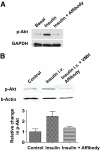Influence of insulin in the ventromedial hypothalamus on pancreatic glucagon secretion in vivo
- PMID: 20299468
- PMCID: PMC2874714
- DOI: 10.2337/db10-0014
Influence of insulin in the ventromedial hypothalamus on pancreatic glucagon secretion in vivo
Abstract
Objective: Insulin released by the beta-cell is thought to act locally to regulate glucagon secretion. The possibility that insulin might also act centrally to modulate islet glucagon secretion has received little attention.
Research design and methods: Initially the counterregulatory response to identical hypoglycemia was compared during intravenous insulin and phloridzin infusion in awake chronically catheterized nondiabetic rats. To explore whether the disparate glucagon responses seen were in part due to changes in ventromedial hypothalamus (VMH) exposure to insulin, bilateral guide cannulas were inserted to the level of the VMH and 8 days later rats received a VMH microinjection of either 1) anti-insulin affibody, 2) control affibody, 3) artificial extracellular fluid, 4) insulin (50 microU), 5) insulin receptor antagonist (S961), or 6) anti-insulin affibody plus a gamma-aminobutyric acid A (GABA(A)) receptor agonist muscimol, prior to a hypoglycemic clamp or under baseline conditions.
Results: As expected, insulin-induced hypoglycemia produced a threefold increase in plasma glucagon. However, the glucagon response was fourfold to fivefold greater when circulating insulin did not increase, despite equivalent hypoglycemia and C-peptide suppression. In contrast, epinephrine responses were not altered. The phloridzin-hypoglycemia induced glucagon increase was attenuated (40%) by VMH insulin microinjection. Conversely, local VMH blockade of insulin amplified glucagon twofold to threefold during insulin-induced hypoglycemia. Furthermore, local blockade of basal insulin levels or insulin receptors within the VMH caused an immediate twofold increase in fasting glucagon levels that was prevented by coinjection to the VMH of a GABA(A) receptor agonist.
Conclusions: Together, these data suggest that insulin's inhibitory effect on alpha-cell glucagon release is in part mediated at the level of the VMH under both normoglycemic and hypoglycemic conditions.
Figures




References
-
- Unger RH: The Banting Memorial Lecture 1975: diabetes and the alpha cell. Diabetes 1976; 25: 136–151 - PubMed
-
- Cryer PE: Banting Lecture: hypoglycemia: the limiting factor in the management of IDDM. Diabetes 1994; 43: 1378–1389 - PubMed
-
- Meier JJ, Kjems LL, Veldhuis JD, Lefèbvre P, Butler PC: Postprandial suppression of glucagon secretion depends on intact pulsatile insulin secretion: further evidence for the intraislet insulin hypothesis. Diabetes 2006; 55: 1051–1056 - PubMed
-
- Banarer S, McGregor VP, Cryer PE: Intraislet hyperinsulinemia prevents the glucagon response to hypoglycemia despite an intact autonomic response. Diabetes 2002; 51: 958–965 - PubMed
-
- Havel PJ, Taborsky GJ, Jr: The contribution of the autonomic nervous system to changes of glucagon and insulin secretion during hypoglycemic stress. Endocr Rev 1989; 10: 332–350 - PubMed
Publication types
MeSH terms
Substances
Grants and funding
LinkOut - more resources
Full Text Sources
Medical
Research Materials

